
Many choices.
Weak diodes.
 Today, I’ll be reviewing the LED grow lights manufactured and sold by ProSource Worldwide. More specifically I’ll be looking at the following seven lights: the 90w Illuminator, 180w Jumbo Illuminator, 350w Pro-series Hybrid, 600w SuperPro Hybrid, Flower Accelerator, 90w Mother Keeper, and the 180w Mother Keeper. Initially I was going to make an individual post for each light, but I soon realized that each of them have a lot in common.
Today, I’ll be reviewing the LED grow lights manufactured and sold by ProSource Worldwide. More specifically I’ll be looking at the following seven lights: the 90w Illuminator, 180w Jumbo Illuminator, 350w Pro-series Hybrid, 600w SuperPro Hybrid, Flower Accelerator, 90w Mother Keeper, and the 180w Mother Keeper. Initially I was going to make an individual post for each light, but I soon realized that each of them have a lot in common.
In the following review I’ll break down each of the lights into the key characteristics you should be looking at when buying an LED grow light. At the end of this review I post links to actual grows using this light. If you have a grow journal using this light, then please post it in the comments so I can add it to the list and others can benefit.
90W Illuminator LED UFO Review
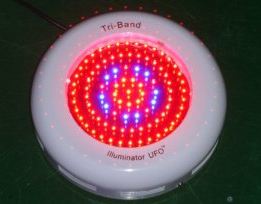 Warranty: A
Warranty: A
Three Years is well above the industry average (I put the average at about 1 year)
Trial Period: A+
90 day Risk-Free (I’m waiting to hear back from Prosource Worldwide if there are any special conditions that must be met for you to get your money back during the trial period? Do you need to document the grow? Do you need special pictures? etc?) I heard back from them, you can read their answers in my interview with ProSource. Basically, you just have to tell them you’re not satisfied with the product. This is probably the best 90-day trial period in the industry. A+
Heat Sink: B+
I contacted ProSource about their heatsink and they said that they haven’t had problems with heat dissipation with any of their lights. I would have liked to hear/see a bit more so B+.
Spectral WaveLength: B+
Red 662, Orange, Blue. ProSource was the first company to come out with the tri-band (three wave-lengths). This was a big deal when it came out and changed the LED growing industry. Now they are running on a five-band light that targets the peak wave-lengths in photosynthesis. I give them a B+ here because I’m starting to find research that indicates orange might not be as important as was previously thought (and green might be more important than was previously thought).
Actual Watts Drawn: A
80 Watts. This is extremely good for a light that is labeled a 90 watt light. Remember that the actual watt draw is an important number because LEDs require more actual watts of power than was initially estimated. In other words, an LED light that only pulls 10 watts of power isn’t an adequate substitute for a 400w HID light.
Beam Angle: A-
This light has beam angles of 90 degrees. This is a pretty popular choice and a good one.
Diode Configuration: 90X1 In other words the lights come with 90 one-watt LED chips.
Price Range: Around $300
My Comments: This UFO and the 180w Jumbo (listed below) are probably the best UFOs on the market. The other major competitors in the market seem to be moving away from the UFO design. I’m not sure if the other companies have found a better design or if they are simply separating themselves from the cheap Chinese manufacturers that originally copied ProSource’s design.
180W Jumbo Illuminator Review 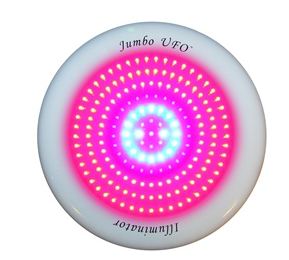 Warranty: A (same as 90 watt see above for comments)
Warranty: A (same as 90 watt see above for comments)
Trial Period: A+(see above for comments)
Heat Sink: B+ (see above)
Spectral WaveLength: A- (see above)
Actual Watts Drawn: A+
The 180 watt illuminator draws about 155 watts of power. This get a slightly higher grade than the 90-watt version listed above because it is drawing a lot more power. Taller plants that flower like tomatoes, cannabis, and peppers require a lot of power.
Beam Angle: A- 90 degrees (see above for commentary)
Diode Configuration: 180X1 In other words it has 180 one-watt LEDs.
Price: Around $600
Comments: For those of you interested in growing taller plants that flower (plants above three feet) I would recommend going with the Jumbo Illuminator instead of the 90w UFO. Many growers have found that they needed the additional power to produce at the rate they wanted to.
350W Illuminator Pro Series Hybrid Review
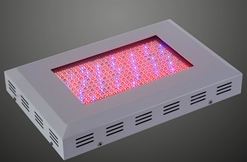 I was very confused why this light was called the hybrid. After talking with the company, I found that it is called the hybrid because of the mixture of 1 watt and 3 watt diodes. The fact that they mixed some 3-watt diodes into the light is a good sign in my opinion (more penetration into the lower canopy). The warranty, trial period, heatsink, beam angle, and spectral wavelength grades are the same for the hybrid as they are for the UFOs. See above for more commentary.
I was very confused why this light was called the hybrid. After talking with the company, I found that it is called the hybrid because of the mixture of 1 watt and 3 watt diodes. The fact that they mixed some 3-watt diodes into the light is a good sign in my opinion (more penetration into the lower canopy). The warranty, trial period, heatsink, beam angle, and spectral wavelength grades are the same for the hybrid as they are for the UFOs. See above for more commentary.
Actual Watts Drawn: 290 watts
600W Illuminator SuperPro Hybrid Review
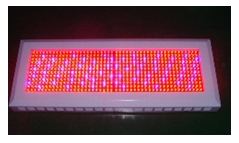
Actual Watts Drawn: 520 watts Everything else is the same as the other lights reviewed above.
90W Flower Accelerator Review 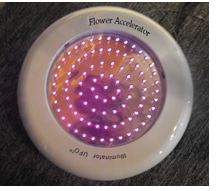 This light is used as a supplemental light to increase flowering. Company says they saw yield increases of better than 20%.
This light is used as a supplemental light to increase flowering. Company says they saw yield increases of better than 20%.
Spectral WaveLength: Far red, proprietary. This is an excellent wave-length for flowering.
Actual Watts Drawn: 55 watts. This is a really low watt-draw, but remember that this light is used as a supplement to increase flowering.
Diode configuration: 90X1 90 one-watt chips.
My Comments: This is an interesting light that could come in handy.
90w Mother Keeper Review 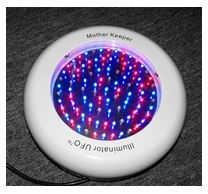 The mother-keepers are meant to be used for cloning purposes. If the mother plant is over 4 feet tall go with the 180 w.
The mother-keepers are meant to be used for cloning purposes. If the mother plant is over 4 feet tall go with the 180 w.
Spectral WaveLength: Red and Blue (pretty heavy on the blue)
Actual Watts Drawn: 85 watts
180w Mother Keeper Review
Actual Watts Drawn: 160 watts
Comments: I have heard really great things about the 180w mother keeper. In other words, it does exactly what the name says it does.
You can take a look at all of the ProSource Lights by heading over to their website found here: ProSourceWorldWide.com
What Others Are Saying/ Actual Grows Note:
The first two grows (listed just below) by a man named Rumple are must reads in my opinion! The guy takes pictures on a regular basis and he summarizes the pros and cons of this light at the end of his post. You don’t need to read all 500 pages where random people are commenting; just read his first post where he summarizes his whole grow. At the end he succinctly mentions all the advantages and disadvantages of the ProSource LED grow lights. I wish every grower did this; it would save us all so much time.
Must Read Threads!
http://forum.grasscity.com/hydroponic-grow-journals/485301-rumples-led-challenge.html http://forum.grasscity.com/hydroponic-grow-journals/541285-rumples-2nd-led-challenge.html
Positive:
This is a video by ProSource Worldwide. The video is biased, but still informative. Make sure to read the comments.
Negative
This video is obviously created by a competitor, but it does illustrate a good point. The 60 degree beam angle seems to be more powerful at longer distances (this is important for people growing taller plants. The music is great for a good laugh too!




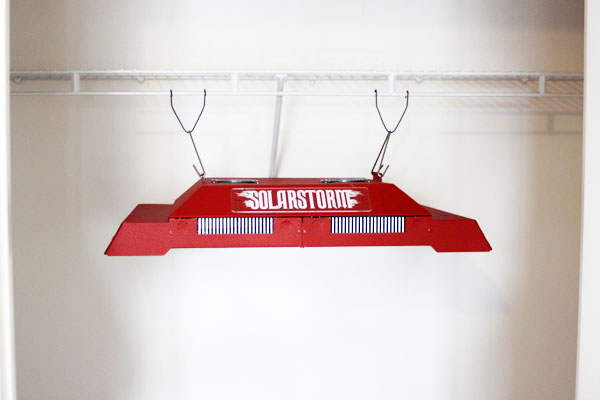
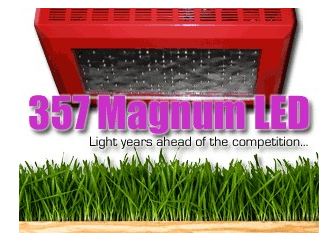
Hello, I’m having trouble picking an led light. Prosource seems to be the best company for customer service and whatnot but their tech hasn’t seemed to improve alot in a while. How do their lights(180w illuminator) stand up to others in it’s class now?